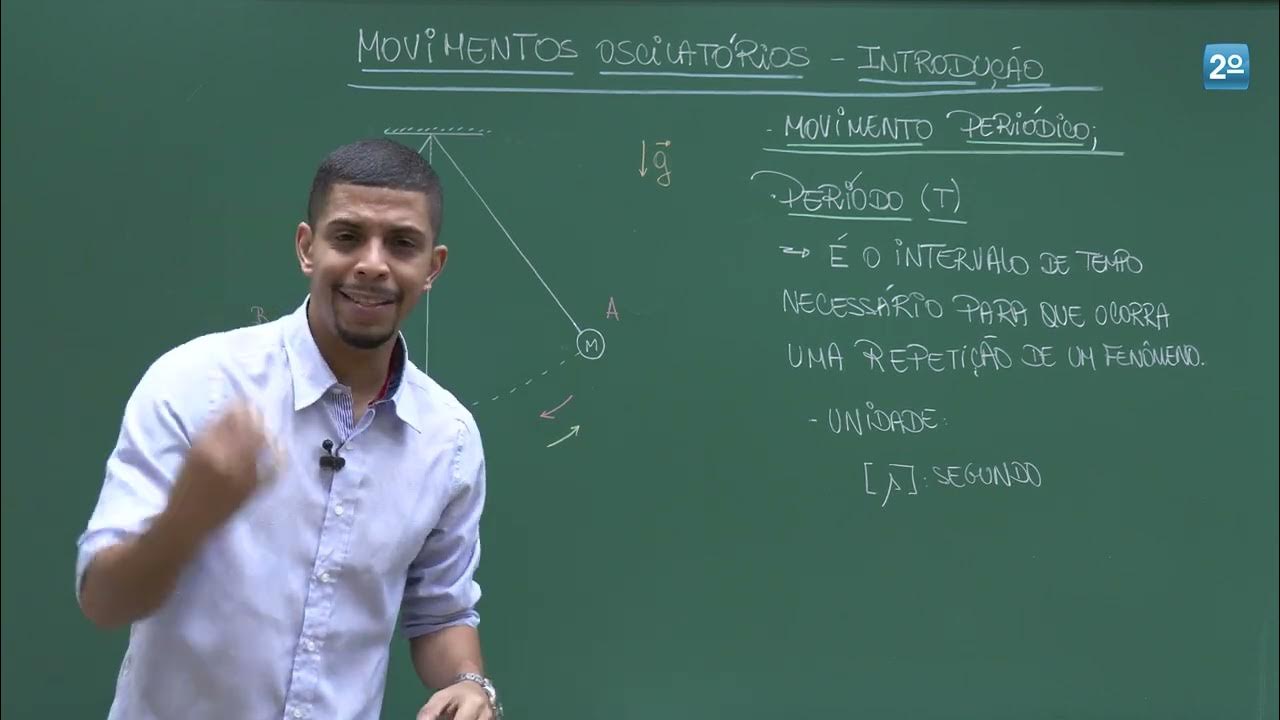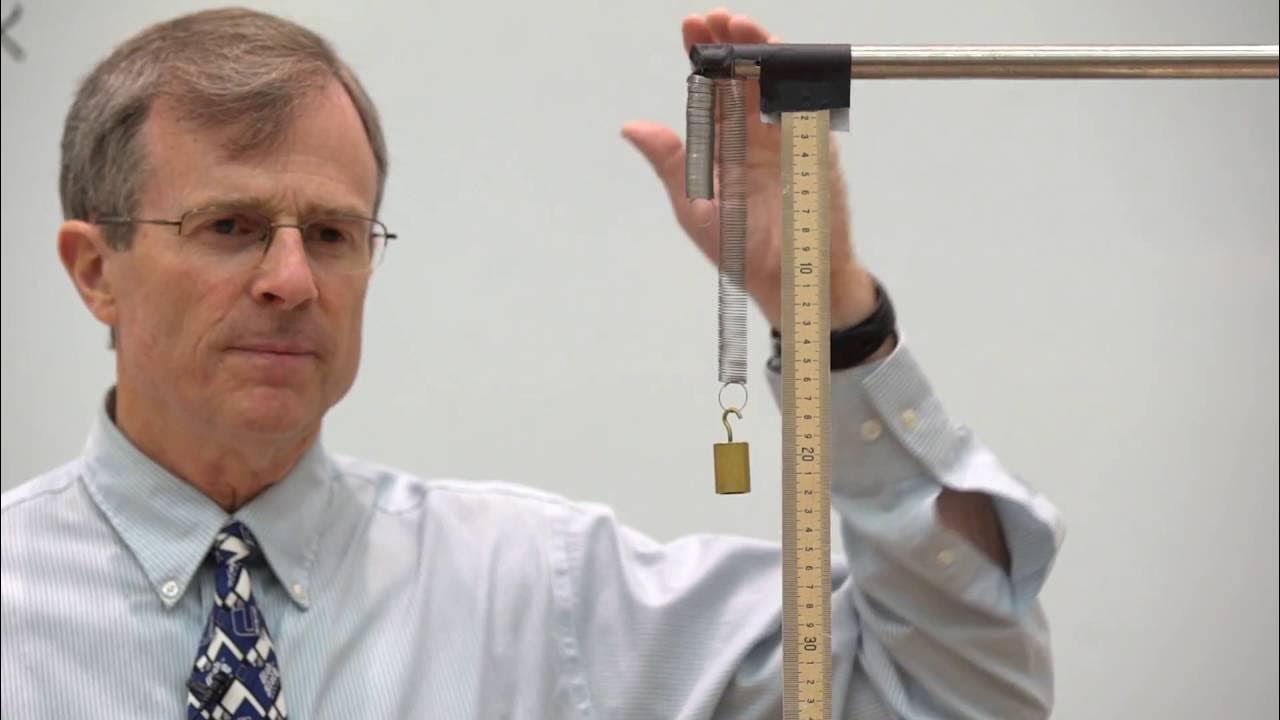M H S aula 03
Summary
TLDRThis educational video delves into the concepts of Simple Harmonic Motion (MHS), focusing on the spring-mass system. It explains key principles like pulsation, frequency, and period, using Hooke's law and Newton's second law to derive motion equations. The lecturer highlights energy conservation in the system, showing the transition between kinetic and potential energy. The video also touches on the idealized oscillation of the spring-mass system, noting real-world damping effects. It serves as a foundation for understanding harmonic motion, with upcoming discussions on related topics like the simple pendulum and acoustic waves.
Takeaways
- 😀 MHS (Simple Harmonic Motion) is a periodic motion characterized by a set period, frequency, and pulsation, which was introduced in the first block of lessons.
- 😀 The motion follows Hooke's Law, where the restoring force is proportional to the displacement: F = -kX.
- 😀 In the mass-spring system, the oscillation is a projection of uniform circular motion onto the x-axis, showing the analogy between these two movements.
- 😀 The acceleration in MHS is related to displacement by the equation a = -ω²x, where ω is the angular frequency.
- 😀 Pulsation (angular frequency) is calculated using the formula ω = √(k/m), where k is the spring constant and m is the mass.
- 😀 The period (T) of oscillation for a mass-spring system is given by T = 2π√(m/k), and the frequency (f) is its reciprocal, f = 1/T.
- 😀 Energy in MHS systems is conserved, shifting between kinetic energy (1/2mv²) and potential energy (1/2kx²) throughout the oscillation.
- 😀 At maximum displacement, the energy is all potential, and at equilibrium, it is all kinetic, ensuring the mechanical energy stays constant in an ideal system.
- 😀 The system behaves conservatively, meaning it can oscillate indefinitely without energy loss, assuming no friction or damping.
- 😀 For real-world systems with friction or other resistive forces, MHS will eventually be damped, but in idealized models, the oscillations continue forever.
- 😀 The next lesson will cover the simple pendulum, another example of MHS, highlighting differences from the mass-spring system.
- 😀 The video emphasizes that MHS concepts are fundamental for understanding waves, energy conservation, and oscillatory motion in physics.
Q & A
What is Simple Harmonic Motion (SHM)?
-Simple Harmonic Motion (SHM) is a periodic motion where the object oscillates back and forth about an equilibrium position, with a constant frequency and amplitude. It is characterized by the restoring force being proportional to the displacement, as seen in systems like mass-spring oscillations.
How is SHM related to Uniform Circular Motion (UCM)?
-SHM can be seen as the projection of Uniform Circular Motion (UCM) onto a linear axis. As a point moves in a circle, its projection onto the x-axis traces the SHM, where the displacement varies sinusoidally over time.
What is the restoring force in SHM?
-The restoring force in SHM is the force that tries to return the system to its equilibrium position. In the case of a mass-spring system, this force is given by Hooke's Law, which states that the force is proportional to the displacement, and is represented by F = -kx.
What is the significance of the negative sign in the restoring force equation F = -kx?
-The negative sign indicates that the restoring force acts in the opposite direction of the displacement. This is what causes the object to return to its equilibrium position.
How is the acceleration in SHM expressed?
-The acceleration in SHM is given by the equation a = -ω²x, where ω is the angular frequency and x is the displacement. This shows that acceleration is directly proportional to the displacement but in the opposite direction.
How is the angular frequency (ω) related to the spring constant (k) and mass (m) in SHM?
-The angular frequency (ω) is related to the spring constant (k) and mass (m) by the formula ω = √(k/m). This shows that the angular frequency increases with a stiffer spring and decreases with a larger mass.
What is the relationship between the period (T), frequency (f), and angular frequency (ω)?
-The period (T) is the time it takes for one complete oscillation, and it is related to angular frequency (ω) by T = 2π/ω. The frequency (f) is the reciprocal of the period, f = 1/T.
What is the formula for the period of a mass-spring system in SHM?
-The period (T) of a mass-spring system in SHM is given by T = 2π√(m/k), where m is the mass of the object and k is the spring constant.
How can the frequency of SHM be found if the period is known?
-The frequency (f) is the inverse of the period (T), so f = 1/T. If the period is known, simply take the reciprocal to find the frequency.
What is the conservation of mechanical energy in SHM?
-In SHM, the total mechanical energy (the sum of potential and kinetic energy) is conserved. At the maximum displacement, the energy is all potential (elastic potential energy), and at the equilibrium position, the energy is all kinetic (due to the maximum velocity). Throughout the oscillation, the energy switches between kinetic and potential but remains constant in a frictionless system.
Outlines

Cette section est réservée aux utilisateurs payants. Améliorez votre compte pour accéder à cette section.
Améliorer maintenantMindmap

Cette section est réservée aux utilisateurs payants. Améliorez votre compte pour accéder à cette section.
Améliorer maintenantKeywords

Cette section est réservée aux utilisateurs payants. Améliorez votre compte pour accéder à cette section.
Améliorer maintenantHighlights

Cette section est réservée aux utilisateurs payants. Améliorez votre compte pour accéder à cette section.
Améliorer maintenantTranscripts

Cette section est réservée aux utilisateurs payants. Améliorez votre compte pour accéder à cette section.
Améliorer maintenantVoir Plus de Vidéos Connexes

Simple Harmonic Motion Introduction(SHM) via a Horizontal Mass-Spring System

Demonstrating What Changes the Period of Simple Harmonic Motion(SHM)

Aula 1 – Movimentos Periódicos e Introdução ao MHS

Comparing Simple Harmonic Motion(SHM) to Circular Motion - Demonstration

Oscillations Demo: Mass Spring System

Simple Harmonic Motion(SHM) - Force, Acceleration, & Velocity at 3 Positions
5.0 / 5 (0 votes)
